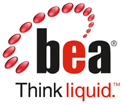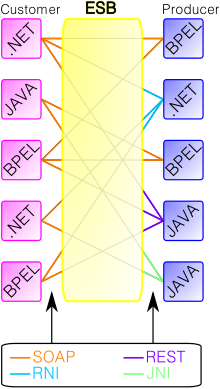The Jakarta Messaging API is a Java application programming interface (API) for message-oriented middleware. It provides generic messaging models, able to handle the producer–consumer problem, that can be used to facilitate the sending and receiving of messages between software systems. Jakarta Messaging is a part of Jakarta EE and was originally defined by a specification developed at Sun Microsystems before being guided by the Java Community Process.
Middleware in the context of distributed applications is software that provides services beyond those provided by the operating system to enable the various components of a distributed system to communicate and manage data. Middleware supports and simplifies complex distributed applications. It includes web servers, application servers, messaging and similar tools that support application development and delivery. Middleware is especially integral to modern information technology based on XML, SOAP, Web services, and service-oriented architecture.

BEA Systems, Inc. was a company that specialized in enterprise infrastructure software products, which was wholly acquired by Oracle Corporation on April 29, 2008.
In software engineering, service-oriented architecture (SOA) is an architectural style that focuses on discrete services instead of a monolithic design. By consequence, it is also applied in the field of software design where services are provided to the other components by application components, through a communication protocol over a network. A service is a discrete unit of functionality that can be accessed remotely and acted upon and updated independently, such as retrieving a credit card statement online. SOA is also intended to be independent of vendors, products and technologies.
Enterprise application integration (EAI) is the use of software and computer systems' architectural principles to integrate a set of enterprise computer applications.
An enterprise messaging system (EMS) or messaging system in brief is a set of published enterprise-wide standards that allows organizations to send semantically precise messages between computer systems. EMS systems promote loosely coupled architectures that allow changes in the formats of messages to have minimum impact on message subscribers. EMS systems are facilitated by the use of structured messages, and appropriate protocols, such as DDS, MSMQ, AMQP or SOAP with web services.
Java Business Integration (JBI) is a specification developed under the Java Community Process (JCP) for an approach to implementing a service-oriented architecture (SOA). The JCP reference is JSR 208 for JBI 1.0 and JSR 312 for JBI 2.0. JSR 312 was removed from the JCP balloting process on 17 Dec, 2010 by the submitters without being accepted.
An XML appliance is a special-purpose network device used to secure, manage and mediate XML traffic. They are most popularly implemented in service-oriented architectures (SOA) to control XML-based web services traffic, and increasingly in cloud-oriented computing to help enterprises integrate on premises applications with off-premises cloud-hosted applications. XML appliances are also commonly referred to as SOA appliances, SOA gateways, XML gateways, and cloud brokers. Some have also been deployed for more specific applications like Message-oriented middleware. While the originators of the product category deployed exclusively as hardware, today most XML appliances are also available as software gateways and virtual appliances for environments like VMWare.
Mule is a lightweight enterprise service bus (ESB) and integration framework provided by MuleSoft. It has a Java-based platform and can alap act as broker for interactions between other platforms such as .NET using web services or sockets.
Oracle Fusion Middleware consists of several software products from Oracle Corporation. FMW spans multiple services, including Java EE and developer tools, integration services, business intelligence, collaboration, and content management. FMW depends on open standards such as BPEL, SOAP, XML and JMS.
This article is a comparison of notable business integration and business process automation software.
IBM App Connect Enterprise is IBM's premier integration software offering, allowing business information to flow between disparate applications across multiple hardware and software platforms. Rules can be applied to the data flowing through user-authored integrations to route and transform the information. The product can be used as an Enterprise Service Bus supplying a communication channel between applications and services in a service-oriented architecture.

A message broker is an intermediary computer program module that translates a message from the formal messaging protocol of the sender to the formal messaging protocol of the receiver. Message brokers are elements in telecommunication or computer networks where software applications communicate by exchanging formally-defined messages. Message brokers are a building block of message-oriented middleware (MOM) but are typically not a replacement for traditional middleware like MOM and remote procedure call (RPC).
OpenESB is a Java-based open-source enterprise service bus. It can be used as a platform for both enterprise application integration and service-oriented architecture. OpenESB allows developers to integrate legacy systems, external and internal partners and new development in business processes. It supports a multitude of integration technologies including standard JBI, XML with support for XML Schemas, WSDL, and BPEL with the aim of simplicity, efficiency, long-term durability, and low TCO.
Oracle Enterprise Service Bus, a fundamental component of Oracle's Services-Oriented Architecture suite of products, provides integration of data and enterprise applications within an organisation and their connected enterprises.

Enterprise Integration Patterns is a book by Gregor Hohpe and Bobby Woolf and describes 65 patterns for the use of enterprise application integration and message-oriented middleware in the form of a pattern language.
Event-driven SOA is a form of service-oriented architecture (SOA), combining the intelligence and proactiveness of event-driven architecture with the organizational capabilities found in service offerings. Before event-driven SOA, the typical SOA platform orchestrated services centrally, through pre-defined business processes, assuming that what should have already been triggered is defined in a business process. This older approach does not account for events that occur across, or outside of, specific business processes. Thus complex events, in which a pattern of activities—both non-scheduled and scheduled—should trigger a set of services is not accounted for in traditional SOA 1.0 architecture.
Middleware analysts are computer software engineers with a specialization in products that connect two different computer systems together. These products can be open-source or proprietary. As the term implies, the software, tools, and technologies used by Middleware analysts sit "in-the-middle", between two or more systems; the purpose being to enable two systems to communicate and share information.
A canonical model is a design pattern used to communicate between different data formats. Essentially: create a data model which is a superset of all the others ("canonical"), and create a "translator" module or layer to/from which all existing modules exchange data with other modules. The canonical model acts as a middleman. Each model now only needs to know how to communicate with the canonical model and dont need to know the implementation details of the other modules.
The JBoss Enterprise SOA Platform is free software/open-source Java EE-based service-oriented architecture (SOA) software. The JBoss Enterprise SOA Platform is part of the JBoss Enterprise Middleware portfolio of software. The JBoss Enterprise SOA Platform enables enterprises to integrate services, handle business events, and automate business processes, linking IT resources, data, services and applications. Because it is Java-based, the JBoss application server operates cross-platform: usable on any operating system that supports Java. The JBoss SOA Platform was developed by JBoss, now a division of Red Hat.




